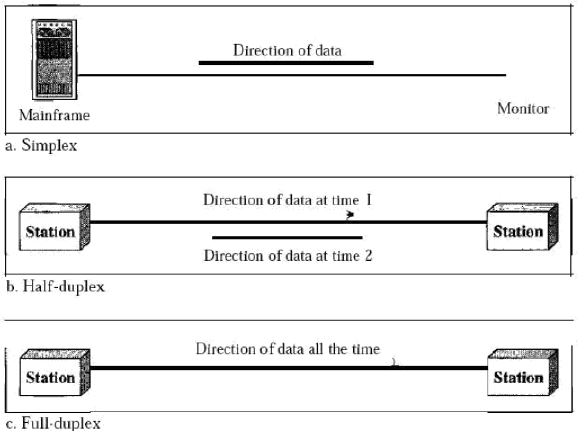Explain the types of transmission modes
Answer:
-Communication between two devices can be simplex, half-duplex, or full-duplex.
Simplex:
In simplex mode, the communication is unidirectional, as on a one-way street. Only one of the two devices on a link can transmit; the other can only receive.
Keyboards and traditional monitors are examples of simplex devices. The keyboard can only introduce input; the monitor can only accept output.
The simplex mode can use the entire capacity of the channel to send data in one direction.
Half-Duplex:
In half-duplex mode, each station can both transmit and receive, but not at the same time. When one device is sending, the other can only receive, and vice versa.
The half-duplex mode is like a one-lane road with traffic allowed in both directions.
When cars are traveling in one direction, cars going the other way must wait.
In a half-duplex transmission, the entire capacity of a channel is taken over by whichever of the two devices is transmitting at the time.
Full Duplex:
In full-duplex mode, both stations can transmit and receive simultaneously.
The full-duplex mode is like a two way street with traffic flowing in both directions at the same time.
One common example of full-duplex communication is the telephone network.
When two people are communicating by a telephone line, both can talk and listen at the same time.

Simplex:
In simplex mode, the communication is unidirectional, as on a one-way street. Only one of the two devices on a link can transmit; the other can only receive.
Keyboards and traditional monitors are examples of simplex devices. The keyboard can only introduce input; the monitor can only accept output.
The simplex mode can use the entire capacity of the channel to send data in one direction.
Half-Duplex:
In half-duplex mode, each station can both transmit and receive, but not at the same time. When one device is sending, the other can only receive, and vice versa.
The half-duplex mode is like a one-lane road with traffic allowed in both directions.
When cars are traveling in one direction, cars going the other way must wait.
In a half-duplex transmission, the entire capacity of a channel is taken over by whichever of the two devices is transmitting at the time.
Full Duplex:
In full-duplex mode, both stations can transmit and receive simultaneously.
The full-duplex mode is like a two way street with traffic flowing in both directions at the same time.
One common example of full-duplex communication is the telephone network.
When two people are communicating by a telephone line, both can talk and listen at the same time.
Share To Friends Via:



 What is network topology ?
What is network topology ?